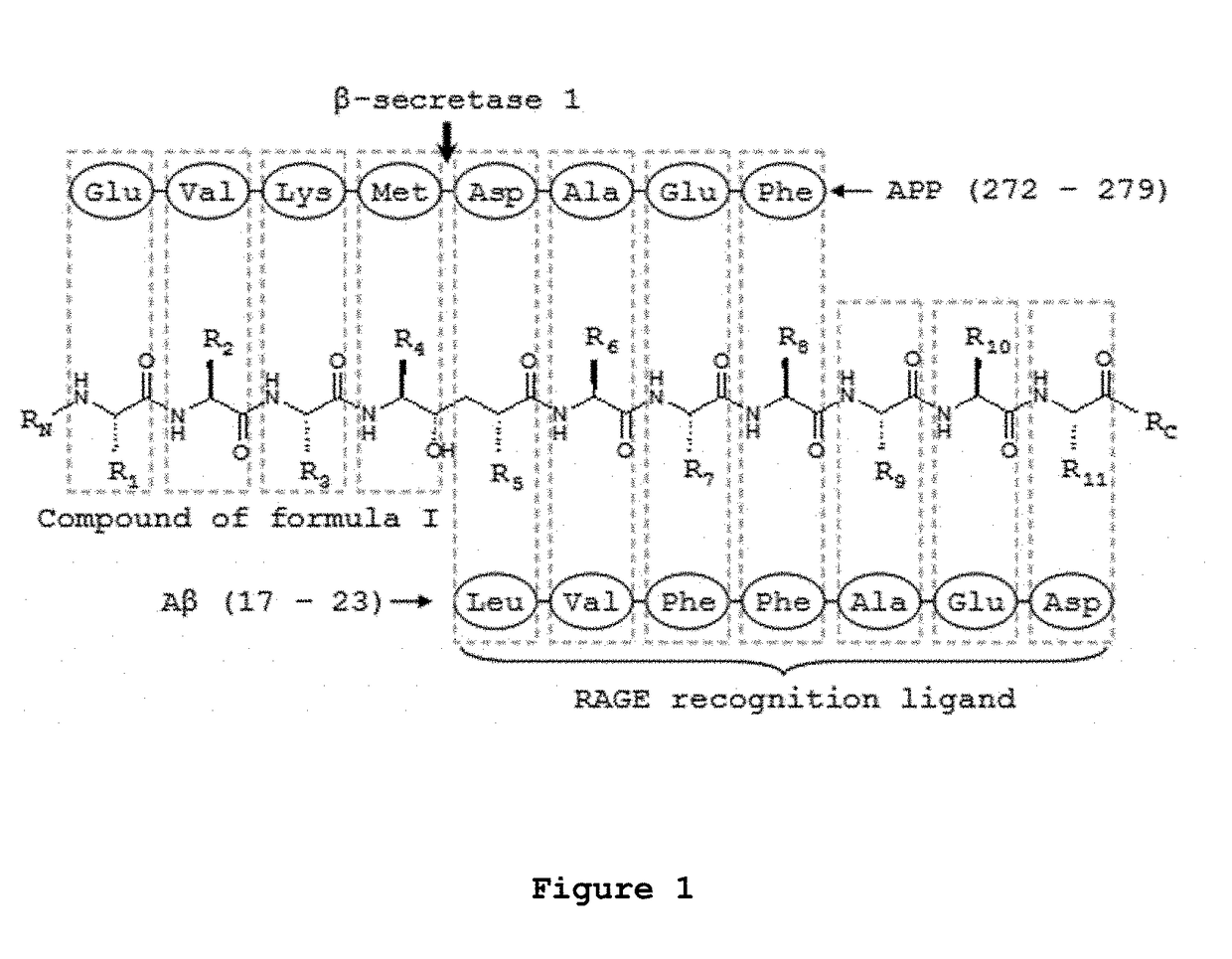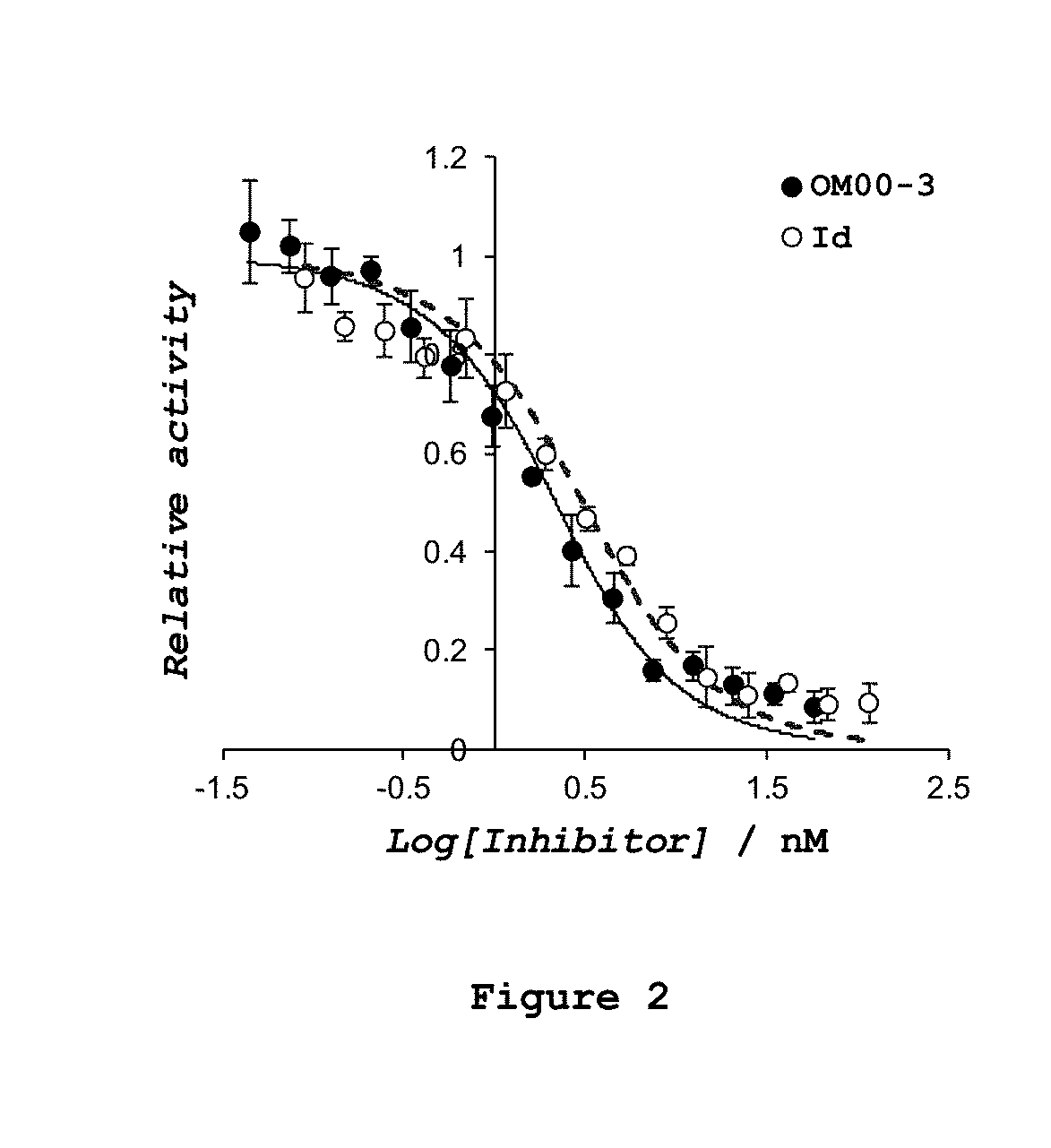Brain permeant peptidomimetic beta-secretase 1 inhibitors for the treatment or prophylaxis of neurological disorders or conditions
a technology of brain permeant peptides and beta-secretase, which is applied in the direction of peptides with abnormal peptide links, peptide/protein ingredients, pharmaceutical active ingredients, etc., can solve the problems of preventing or preventing progression and affecting the prognosis of brain amyloid angiopathy
- Summary
- Abstract
- Description
- Claims
- Application Information
AI Technical Summary
Benefits of technology
Problems solved by technology
Method used
Image
Examples
example 1
Synthesis of a Compound of Formula IX
[0194]To a stirred solution of compound II, N-(tert-Butyloxycarbonyl)-L-leucine, (5.00 g, 21.6 mmol) in dry dichloromethane (DCM) (100 mL) under Ar atmosphere at room temperature, N,O-dimethylhydroxyamine hydrochloride (DMHA) (3.16 g, 32.4 mmol) was added. The resulting mixture was stirred for 10 minutes at room temperature. 4-Methylmorpholine (2.4 mL, 21.6 mmol) was added dropwise. In a separate flask, EDC (6.21 g, 32.4 mmol) was dissolved in dichloromethane (20 mL) under Ar atmosphere. The resulting mixture was added dropwise to the above solution of N,O-dimethylhydroxyamine hydrochloride and 4-Methylmorpholine.
[0195]The reaction mixture was kept stirring, under Ar atmosphere at room temperature for 2 days. The reaction was quenched with water and the layers were separated. The aqueous layer was extracted with dichloromethane (3×50 mL). The organic layer was dried over anhydrous MgSO4 and concentrated under reduced pressure. Compound III was ob...
example 2
Synthesis of a Compound of Formula I
[0205]This compound was synthesized following a manual standard Solid Phase Peptide Synthesis procedure. This procedure is characterized by successive deprotection / coupling cycles to assemble the amino acids into a peptide. These cycles include both a deprotection and a coupling step. In the deprotection step Fmoc is removed from the amino terminus. For this, 20% piperidine in dimethylformamide (15 mL) is added to the resin and the reaction mixture is stirred at 25° C. under nitrogen atmosphere for 15 minutes. After this time the reaction mixture is filtered using vaccum and resin is washed with dimethylformamide (6 mL). This deprotection step is repeated twice to assure complete Fmoc deprotection. Completion of this step it is monitored by TLC (diethyl ether:hexane (3:2)) by UV-Vis spectroscopy following the release of the Fmoc protecting group. In the coupling step Fmoc protected amino acids are added to the resin. For this, to the stirred resin...
example 3
Influence of Conjugation of the Compound OM00-3 with A / β 17-23′ on BACE-1 Inhibition Potency
[0207]An assay for BACE-1 activity was accomplished in order to test the effective BACE-1 inhibition when OM00-3 is conjugated with Aβ 17-23′. Therefore, kinetic experiments were performed in 20 mM sodium acetate buffer, pH 4.5 at 37° C. in 15% dimethyl sulfoxide (DMSO), 1% triton X-100 (Sigma-Aldrich), 250 nM of Mca-SEVNLDAEFK-DNP (Bachem) as substrate and 2 U / mL of BACE-1 (human, recombinant, 21267 U / mg, purity>90%, Sigma-Aldrich). The initial rates of substrate hydrolysis were confirmed to be directly proportional to the enzyme concentrations in a range of 1-5 U / mL. Initial rates were determined below conversion of 5% of substrate, after stopping the reaction with 25% of a 2.5 M sodium acetate solution after 2 hours. The hydrolysis of the fluorogenic substrate was quantified by reverse phase HPLC with fluorescence detection (HPLC-FLU) using an excitation wavelength of 323 nm and an emissio...
PUM
| Property | Measurement | Unit |
|---|---|---|
| temperature | aaaaa | aaaaa |
| pressure | aaaaa | aaaaa |
| pressure | aaaaa | aaaaa |
Abstract
Description
Claims
Application Information
 Login to View More
Login to View More - R&D
- Intellectual Property
- Life Sciences
- Materials
- Tech Scout
- Unparalleled Data Quality
- Higher Quality Content
- 60% Fewer Hallucinations
Browse by: Latest US Patents, China's latest patents, Technical Efficacy Thesaurus, Application Domain, Technology Topic, Popular Technical Reports.
© 2025 PatSnap. All rights reserved.Legal|Privacy policy|Modern Slavery Act Transparency Statement|Sitemap|About US| Contact US: help@patsnap.com



